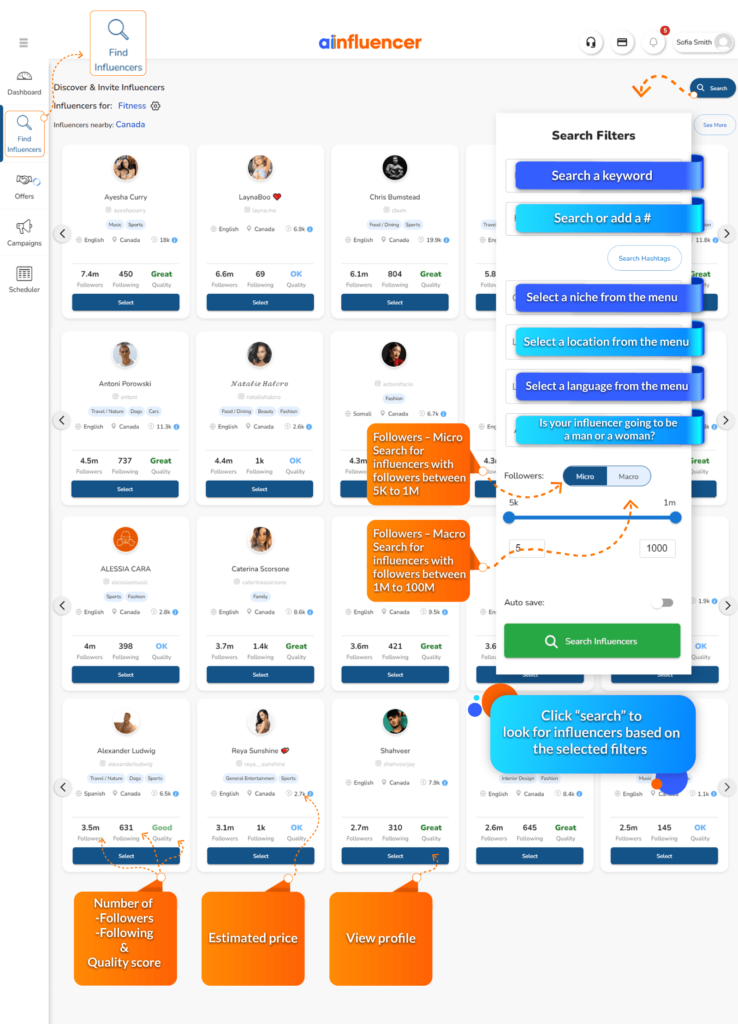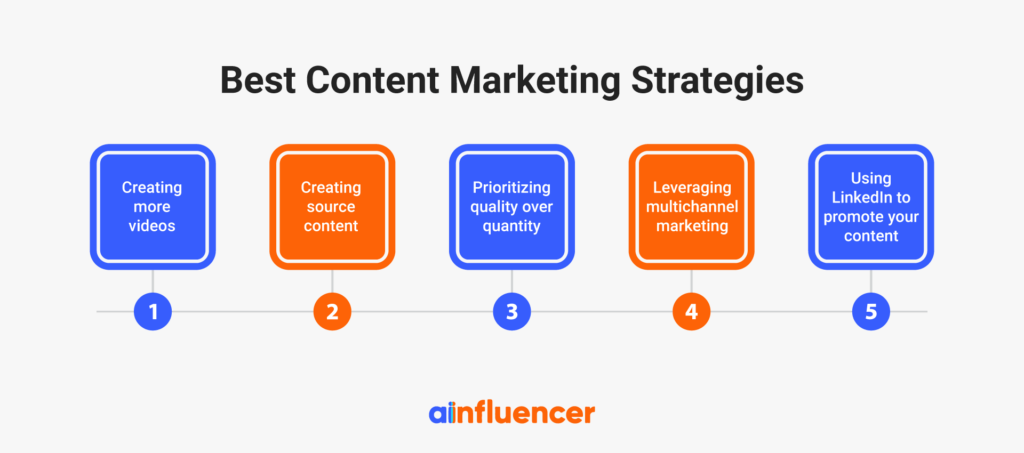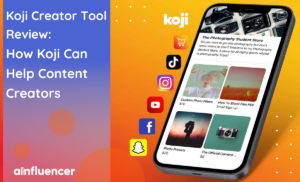Content marketing is a crucial aspect of any successful marketing strategy in today’s digital age. In 2024, developing an effective content marketing strategy is more critical than ever. In this guide, we will see why you need to create a content strategy, explore the steps to create a perfect one, and go through some content marketing tips and content strategy examples to inspire you.
Do I really need to create a content marketing strategy?
Suppose you’re wondering whether to create a content marketing strategy. In that case, we should mention that it is necessary for any marketing plan, as it brings so many benefits, including helping establish your brand, building relationships with your target audience, and driving profitable customer action.
A well-defined strategy ensures that your content is aligned with your overall business goals and effectively reaches and resonates with your target audience. By developing a comprehensive strategy, you’ll set yourself up for success and achieve better results from your content marketing efforts.
How to create a content marketing strategy?
Content marketing is the process of creating and distributing valuable, relevant, and consistent content to attract and retain a clearly defined audience and ultimately drive profitable customer action. To create a successful content marketing strategy, you need to follow the upcoming steps:

1. Create a marketing plan
The first step to creating content marketing strategies is to create a marketing plan. It means defining your company’s marketing objectives and creating a plan to achieve them.
When creating a plan for your company, you need to consider your company’s products or services and analyze your competitors to understand your market better.
2. Create buyer personas
Creating buyer personas is also an essential step in content creation strategies. A buyer persona is a semi-fictional representation of your ideal customer based on market research and real data about your existing customers.
The information gathered can be used to understand how they think, feel, and shop. It also helps you create personalized content that resonates with your target audience.
When creating a buyer persona, you need to consider demographics, psychographics, buying habits, goals, and pain points. This information can help shape the message and tone of the content so it better connects with your audience’s interests.
3. Identify your existing audience
The next step in your content planning is to analyze your existing audience and understand who you are writing for. It will help you create content that speaks directly to them and their needs. Without a clear picture of who your target audience is, crafting relevant and meaningful pieces of work can be difficult as you’re not sure what will resonate with them.
4. Set SMART goals
Creating SMART goals for your content marketing strategy is the next step. It involves defining specific, measurable, achievable, relevant, and time-bound objectives for your campaigns. This approach helps ensure that your efforts are focused, trackable, and aligned with your overall marketing and business goals.
5. Determine your KPIs
When creating a content marketing plan, it’s also essential to determine key performance indicators (KPIs) that will help you measure and evaluate the success of your efforts. KPIs are metrics, such as traffic and ROI, that provide insights into how well your content is performing and help you identify areas for improvement.
6. Select the required tools
After determining your KPIs, you need to select the right tools to ensure that all your content marketing efforts yield the best results. The right content marketing toolkit enables marketers to create, measure, and optimize their strategies.
It’s essential to select the best tools for each job, as they can provide assistance in various ways, such as increasing visibility and engagement or helping with research and analysis. Before selecting any tool, it’s important to consider its purpose, function, cost, and user experience.
7. Choose your desired channels
One of the other important steps for having an effective content marketing strategy starts with deciding which channels are the best for you to deliver your message.
There are many options available such as social media, blogs, email newsletters, website pages, and more. Whether you’re just starting out or looking to expand your current strategy, you need to assess your target audience and what types of channels they are most likely to be using. For example, if you’re targeting young adults, you may want to focus on mobile-friendly platforms such as Instagram and Snapchat. If you’re targeting an older demographic, then email newsletters might be the best option for reaching them.
8. Select your desired type of content
Another step in creating a strong content marketing strategy is to select the type of content that best meets your needs.
Content can come in many forms, such as blog posts, social media updates, podcast episodes, videos, and more. Each type has its own advantages when it comes to engaging your target audience and increasing brand awareness.
By selecting the content types that fit into your overall marketing plan, you can ensure that each piece contributes to achieving strategic objectives like building relationships with customers or driving conversions.
9. Set your budget
One key factor that should not be overlooked in content planning is the budget. Setting a budget will help ensure you properly allocate funds to the right areas while staying within overall financial goals.
When it comes to budgeting for your content strategy, the most important step is to determine the total amount you can realistically spend on content creation or campaigns over a given period of time. It’s also beneficial to break down this budget into various categories so that you can allocate resources toward specific projects or initiatives.
This could include design costs associated with creating digital assets, as well as any fees associated with boosting posts on social media platforms, just to name a few examples.
10. Create the content
After doing all the above-mentioned steps – defining your target audience, goals, KPIs, etc. – the next step is to create the content itself. This involves identifying key topics to focus on, doing keyword research, and creating a content calendar to plan and schedule the content. The content should align with your overall strategy and be designed to engage and educate your target audience while also promoting your brand.
11. Plan social media campaigns
Having a strong social media presence is essential for any content marketing strategy. If you want to stand out from the competition and maximize your reach, investing in social media campaigns is key.
A successful campaign requires careful planning and execution to ensure that it reaches the widest possible audience and results in a positive return on investment.
One way to plan an effective social media campaign is to create a timeline of activities and milestones for each platform you’re targeting. Your timeline should include when you’ll launch the campaign, how often you’ll post content when you monitor performance metrics, and what adjustments or changes will be made as needed.
You can find influencers for your campaigns on influencer marketplaces, such as Ainfluencer. This DIY marketplace allows you to run different influencer campaigns and search and invite your targeted influencers through its AI search engine.

12. Track the results
Many marketers forget about the last step of creating a content marketing strategy – tracking the results.
Tracking your results should be an ongoing process that helps guide your decisions along the way. This includes keeping track of website visits, page views, conversions, engagements (likes/shares/comments), and any other analytics related to your goals. Doing this can help you identify which elements of your content are working well and where improvements need to be made. Additionally, it’s important to keep track of costs associated with production or promotion so that you know you’re getting a good return on investment (ROI).
Best content marketing strategies in 2024
In 2024, successful content marketing strategies will be so important for promoting your brand. To stay ahead of the curve, consider these tactics:

1. Creating more videos
With the rise of video consumption, it’s important for you as a marketer to incorporate video content into your marketing strategies. Videos can be used to showcase products, explain complex concepts, or share customer stories in an engaging way.
2. Creating source content
Source content refers to original, informative, and educational content that positions a company as a thought leader in their industry. This type of content helps establish trust and credibility with potential customers, making it an important aspect when you create content strategy.
3. Prioritizing quality over quantity
The focus of content marketing in 2024 will be on creating high-quality, valuable content that provides a positive user experience. This means that you should prioritize creating a limited amount of high-quality content over a large amount of low-quality content.
4. Leveraging multichannel marketing
To reach a wider audience, it is important to utilize multiple channels for content distribution. This includes social media, email, and in-person events, among others. A multi-channel approach will increase the visibility of content and drive more traffic to a website.
5. Using LinkedIn to promote your content
LinkedIn has become an important platform for B2B marketers, providing opportunities to connect with professionals, share thought leadership content, and build relationships. It would be of great help if you use LinkedIn to promote your content and drive traffic to your website, making it an integral part of your content marketing strategy.
Examples of successful content marketing campaigns
Content marketing campaigns aim to educate, inform, and engage target audiences by creating and sharing valuable, relevant, and consistent content. Successful content marketing campaigns drive business results, increase brand awareness, and foster customer loyalty. Here are two examples of successful content marketing campaigns:
1. Red Bull’s “Stratos”

Red Bull’s “Stratos” campaign was a content marketing effort that followed the Austrian skydiver Felix Baumgartner as he set a world record for the highest-ever freefall jump.
Red Bull documented the entire event, from Baumgartner’s preparations to the actual jump, and shared the content through social media, their website, and traditional media outlets.
The campaign was a massive success, generating over 50 million views on YouTube and establishing Red Bull as a leader in extreme sports content marketing.
2. Airbnb’s “Live There”

Airbnb’s “Live There” campaign was a content marketing effort that encouraged travelers to immerse themselves in local cultures by staying in an Airbnb accommodation.
The campaign was centered around a series of beautifully-shot and emotionally-compelling videos that showcased the unique experiences available through Airbnb. The success of the campaign by using great content marketing strategies helped to establish Airbnb as a leader in travel and lifestyle content marketing.
Conclusion
In conclusion, developing a content marketing strategy for 2024 is necessary to ensure success in the ever-changing digital landscape. By understanding your audience, setting objectives and KPIs, creating engaging content, and the other above-mentioned tips, you can create a successful content marketing strategy that will help your business reach its goals. Additionally, using Ainfluencer to find influencers that best fit your niche and collaborate with them can help take your content marketing efforts to the next level.
FAQs
There are four main categories of content marketing:
Articles/ blogs;
Visuals (e.g., infographics, videos);
Social media campaigns;
Podcasts.
In 2025, marketing will continue to evolve with technological advancements and shifts in consumer behavior. Marketing strategies will likely become more data-driven, with a greater emphasis on personalization and targeting specific segments. Augmented reality and virtual reality experiences may play a larger role in marketing campaigns, providing immersive and interactive ways for customers to engage with brands. AI and machine learning algorithms will be utilized to better understand consumer behavior and preferences and to automate repetitive marketing tasks. Social media marketing will remain an essential part of the mix, but with increased scrutiny on privacy and data protection, companies will need to find new and innovative ways to connect with customers. The use of influencer marketing may also continue to grow as people turn to trusted sources for product recommendations. Overall, the future of marketing in 2025 will require companies to be agile, adaptable, and innovative in their approach.
Content marketing is an essential part of modern-day digital marketing – and it’s set to become even more important as time goes on. Understanding the five key pillars of content marketing is critical if you want to build a successful, long-term digital marketing strategy.
The five pillars of content marketing are as follows:
1) Understanding your audience, which involves identifying your target market and their needs, preferences, and pain points to create content that appeals to them.
2) Mapping content to the sales cycle, which means aligning the content with the various stages of the customer journey, from awareness to consideration to purchase.
3) Creating content, which involves producing high-quality, relevant, and valuable content in various formats such as blog posts, videos, infographics, etc.
4) Promoting content which means disseminating the content through various channels such as social media, email marketing, influencer marketing, etc., to reach a wider audience.
5) And measuring and analyzing, which tracks the performance of your content and uses the insights gained to refine your content marketing strategy and make data-driven decisions.









